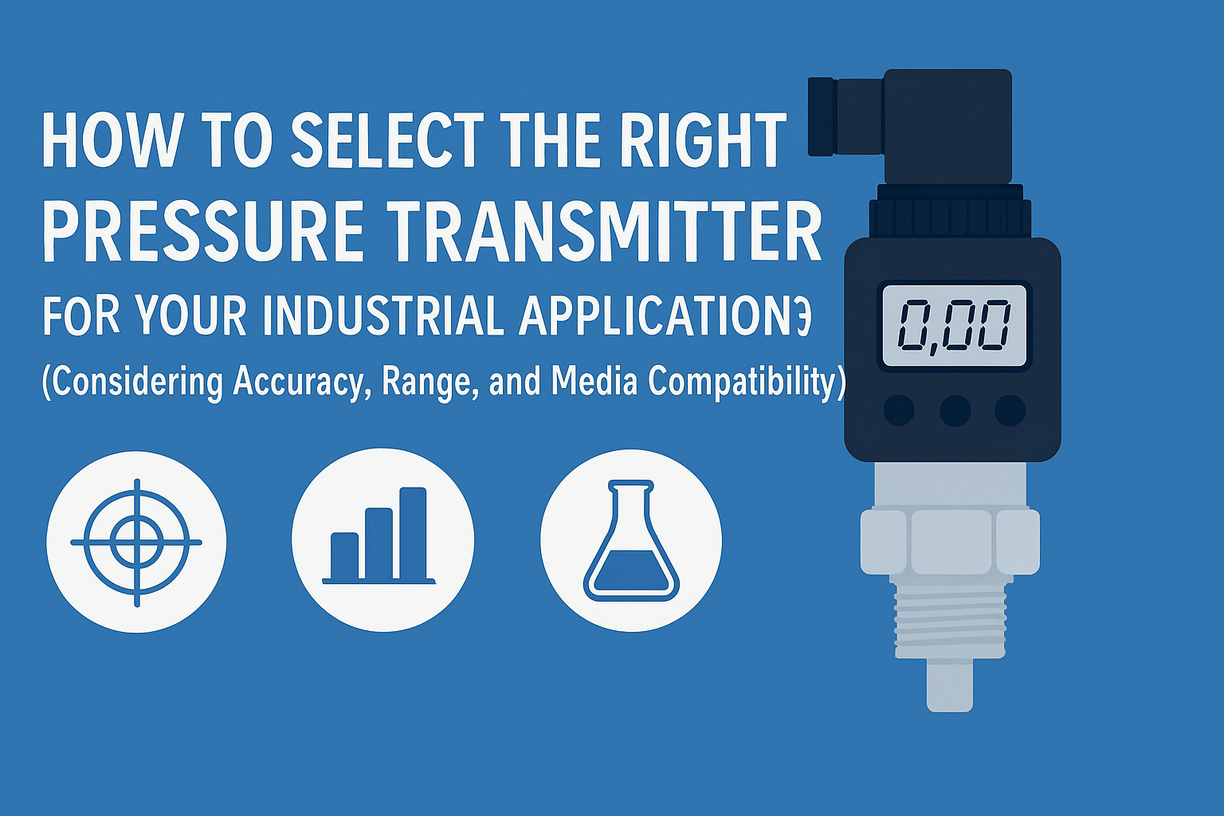How to Select the Right Pressure Transmitter for Your Industrial Application? (Considering Accuracy,
 How to Select the Right Pressure Transmitter for Your Industrial Application? (Considering Accuracy, Range, and Media Compatibility)
How to Select the Right Pressure Transmitter for Your Industrial Application? (Considering Accuracy, Range, and Media Compatibility)
In industrial automation, pressure transmitters are critical instruments used across a wide range of industries, including oil & gas, chemical processing, power generation, pharmaceuticals, food and beverage, and water treatment. However, different applications require different types of transmitters. Selecting the right pressure transmitter can directly impact system stability, operational safety, and long-term maintenance costs.
This article provides a professional guide on how to choose a suitable pressure transmitter by focusing on accuracy, measuring range, and media compatibility, helping engineers and buyers make informed decisions.
1. Understanding Your Application Is the First Step
Before choosing a pressure transmitter, consider the following key questions:
What is being measured? (Gas, liquid, or steam?)
Is the process medium corrosive, viscous, or prone to crystallization?
What are the operating and ambient temperatures? Any vibration or explosion-proof requirements?
Are you measuring gauge pressure, absolute pressure, or differential pressure?
What type of output signal does your PLC/DCS system require?
Having clear answers to these questions will significantly narrow down your selection.
2. Accuracy: Crucial for System Stability and Control Precision
Why Accuracy Matters
High accuracy ensures precise control of critical processes, such as:
Differential pressure flow measurements
Precise dosing in chemical processes
Boiler pressure monitoring and protection systems
Choosing the Right Accuracy Level
Typical industrial pressure transmitters have accuracy levels ranging from ±0.1% to ±0.5% of full scale (FS). For high-precision applications, select ±0.1% FS or better, such as 0.075% FS.
3. Measuring Range: Avoid Overload and Ensure Sensitivity
Selection Principle
Normal operating pressure should be within 30% to 70% of the transmitter’s full-scale range
Avoid oversized ranges that reduce resolution or undersized ranges that risk overload
Example: For a working pressure of 0–6 bar, choose a transmitter with a 0–10 bar range rather than 0–100 bar.
Adjustable Range Advantage
Advanced transmitters offer turndown ratios, allowing the range to be customized for various applications, increasing flexibility and inventory efficiency.
4. Media Compatibility: Key to Long-Term Stability
Focus Areas
Wetted parts material (316L stainless steel, Hastelloy, Tantalum, ceramic, etc.)
Diaphragm type (flush diaphragm for viscous media; recessed diaphragm for clean fluids)
Need for diaphragm seals or fill fluids
Examples
Highly corrosive media: Choose Tantalum diaphragm or PTFE-coated options
High-temperature steam: Use diaphragm seal type with cooling elements
Slurry, wastewater, or media with particles: Prefer flush diaphragm or flange-mount design
5. Output Signal & Communication Protocols
Common signal types include:
4–20mA (ideal for long-distance, interference-resistant transmission)
0–10V, RS485, Modbus, HART, PROFIBUS, etc.
Choose according to your system's requirements and whether remote diagnostics or configuration is needed.
6. Other Key Considerations
Parameter | Recommendation |
Power Supply | 24VDC (most common; match with system requirements) |
IP Rating | IP65 / IP67 / IP68 depending on environmental exposure |
Explosion Proof | Ex ia or Ex d for hazardous areas |
Display Options | Local LCD/LED display for field monitoring |
Certifications | CE, SIL, ATEX, RoHS, ISO, etc., depending on market needs |
7. Summary: Pressure Transmitter Selection at a Glance
Factor | Recommendation |
Accuracy | ±0.1% FS for precision control; ±0.5% FS for general use |
Range | Select a range slightly higher than the process pressure |
Material | Match with media characteristics (e.g. corrosion resistance) |
Output | Ensure compatibility with your control system (e.g., 4–20mA, RS485) |
Structure | Choose diaphragm/seal types based on media condition |
8. Choose ZINACA — Your Partner for Tailored Pressure Solutions
As a professional manufacturer of pressure, flow, temperature, and level instrumentation, Tianjin ZINACA Intelligent Equipment Co., Ltd. offers a wide range of pressure transmitters, including:
Smart pressure transmitters with display and HART protocol
Compact economic models for OEM and general applications
Explosion-proof pressure transmitters
Flush diaphragm, remote seal, and special-media solutions
Visit our website: www.zinaca.net for product catalogs and technical support, or contact us directly via email: zinacaoverseas@gmail.com
Let ZINACA help you find the ideal solution for your measurement needs.

 Click to consult us
Click to consult us